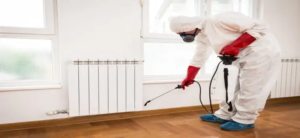When homeowners think of exterminators, they often envision someone in a hazmat suit spraying rooms full of harsh chemicals. But that’s not the whole story.
In addition to eliminating pests, exterminators also help prevent their return by using long-term prevention methods like baits, traps, and one-way valves. To do that, they must first perform a thorough inspection. Contact Exterminator Bakersfield now!

Everyone wants a comfortable home and a productive workplace, but pests disrupt that peace. Whether it’s ants marching across your kitchen counter or mice scurrying through your office, these unwanted intruders are not only annoying but potentially dangerous to health and property. Identifying the pests is crucial for effective control.
A professional exterminator will know what to look for and have a broad range of methods available for eradication. Some techniques involve chemical treatments that are less harmful to humans and pets than DIY solutions, while others use traps, baits, heat treatment, fumigation, or other nontoxic measures. Exterminators will select the most appropriate method based on the type of pest, its extent of damage, and how quickly the infestation needs to be controlled.
Pests often leave clues that make them easy to recognize. For example, weevils chew around leaf edges and leave distinct trails of destruction, while caterpillars leave distinctive holes in leaves. In addition, many pests follow specific feeding patterns that can be identified by observing where and when they feed.
An exterminator’s job also involves inspecting and identifying pest problems in residential and commercial settings, and providing clients with recommendations for long-term prevention. For example, a homeowner may need to change the way food is stored in the pantry or rethink how plants are placed near structures. In industrial settings, an exterminator may work in confined spaces with hazardous materials and must be able to follow strict safety protocols.
Proper identification of pests is critical because insects and rodents can carry germs that cause illness, and some spread diseases that are harmful to human and animal health. Mosquitoes, for instance, can spread encephalitis and other illnesses, while fleas can cause plague, typhus, and other deadly diseases. Insects that bite can transmit tapeworms and other parasites. It’s essential to identify pests down to the species level to develop effective management strategies. This ensures that harmful organisms are targeted, while minimizing the impact on beneficial insects and animals.
Getting to the Root of the Problem
In order for pest control professionals to fully exterminate an infestation they must be able to understand and identify the cause. This is why a thorough inspection by a trained professional is so important. It is not only helpful to determine the exact type of pests infesting a home, but it also allows the professional to know which treatment methods and products are best for the situation.
Many people have a very black and white view of the role that an exterminator plays, picturing someone running around with sprays aimed at killing unwanted pests. However, this is not the case. An exterminator can provide a much more effective service by examining the reasons behind an infestation and offering suggestions on how to change the environment that is drawing the pests in.
For example, if an infestation is caused by a lack of cleanliness, the solution may be to clean more thoroughly. This will eliminate the food sources that attract the pests and make it harder for them to survive in the home. Likewise, if an infestation is the result of an improperly sealed house, the solution may be to seal the cracks and crevices that allow pests in.
An experienced exterminator will be able to provide the right solution for each type of pest problem. For instance, the chemicals used to kill cockroaches and bed bugs are very different from those needed to get rid of fleas or ants. The experienced pest control specialist knows the right products to use and can avoid using overly toxic solutions that can cause health problems for humans, pets or plants.
Pests can not only damage the integrity of a building but can also pose serious health problems. For example, rodents can carry diseases such as hepatitis and salmonella and pests like fleas and cockroaches can spread dangerous bacteria. In addition, certain pests like stinging bees can cause serious injuries to human and animal victims.
Experienced exterminators can help prevent these issues with regular pest control maintenance programs. These programs, which are sometimes referred to as pest management or preventative pest control, include a schedule of visits by an exterminator who will come to the property on a routine basis and spray the home and yard to help keep pests away. This kind of maintenance can save a homeowner from the expense and inconvenience of dealing with major pest infestations and help prevent them in the future.
Treatment
When the detailed pest inspection is complete, an exterminator will go over all of your treatment options. This may include bait traps, chemical sprays and other forms of extermination, depending on the nature of the infestation. The exterminator will also provide you with a schedule of visits and make themselves available to answer any questions you have about the process.
A professional exterminator will know how to use chemicals in a safe manner that is less likely to affect your family or pets. They will also be able to identify entryways into your home that are susceptible to pests and seal them so that they can’t get in again.
Another way that exterminators help you is by reducing your risk of illnesses that some pests can cause. Pests such as mosquitoes, fleas and ticks can all spread diseases through their bites, droppings and more. Exterminators can reduce your risk of illness by eliminating these pests and lowering the number that can carry them.
An exterminator will also look for secondary damage that you may not have noticed. For example, if raccoons or squirrels have been in your attic, they may leave behind feces and other bio-hazards that can create health hazards if not cleaned properly. This can include a potential fire hazard if the feces come into contact with insulation or other flammable materials.
If you’re a homeowner, an exterminator can help you to prevent further damage by helping you to seal any entry points that are vulnerable to pests and installing door sweeps. They can also recommend certain maintenance routines, such as scrubbing your gutters regularly to prevent blockages and keep them flowing freely.
One of the most important things that an exterminator can do for you is to eliminate pests before they multiply and cause extensive damage. This is done through a variety of methods, including spraying, trapping, baiting and even fumigation. In some cases, a combination of these methods is necessary to get rid of a pest problem completely. The exterminators at Loyal Termite & Pest Control have the skills and knowledge necessary to eliminate your pests safely, effectively and permanently.
Prevention
In addition to pest control, exterminators often provide preventative services. This may include advising clients on sanitation and structural issues that contribute to pest infestations. They can also recommend specific products or treatments that can help prevent recurrence of pest problems.
In residential settings, pest exterminators typically work on single-family homes, apartments, or condos. They may also work on businesses, such as restaurants, hotels, or offices. In these settings, pest exterminators must be able to communicate effectively with customers and employees and implement preventative measures.
Pest exterminators use a variety of tools to rid a home or business of pests. They typically begin by conducting an inspection and identifying the type of pests present. They then develop a plan of action that may involve chemical sprays, bait traps, or other treatment methods. In some cases, exterminators must also carry out structural repairs to prevent pests from gaining entry into a building.
Getting rid of pests takes time, so it is important to call an exterminator as soon as you notice a problem. This will allow them to catch the problem before it gets out of hand and save you a lot of money in the long run.
Homeowners can prepare for exterminators by removing clutter and scrubbing surfaces. This will make it easier for them to access hard-to-reach areas and improve the effectiveness of the treatment. Additionally, homeowners should ask their exterminators about how long they need to wait before entering the house after treatment. This is because if you enter the house too early, the chemicals will be absorbed through your skin and lungs which can cause respiratory problems.
Finally, it is a good idea to open all windows and doors after treatment to let the house air out. This will prevent the spread of the pest control chemicals throughout the house. It is also a good idea to wear rubber gloves and avoid contact with any treated surfaces until they are dry. It is also a good idea to wipe down the kitchen counters and other surfaces with a mixture of water and vinegar after treatment to remove any residual toxins.


